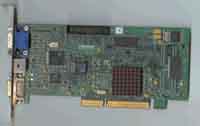The Card
| The Stealth III S540 is a fairly clean cut card, extending about an inch longer than most TNT and Savage4 cards. The placement and integration of all resistors, capacitors, and the single voltage regulator on the board is very professionally done and contributes not only to the aesthetic look of the card, but also insures that the card outputs the highest quality images possible, courtesy of the filters placed between the Savage4/frame buffer and the VGA output itself. Note that the picture to the right is of a pre-release sample and not the final S540 board from Diamond. |
The 2D image quality, as briefly alluded to above, is quite strong courtesy in part by the integrated 300MHz RAMDAC of the 0.25-micron Savage4 chip. The other half of the 2D image quality equation comes from the design of the card itself, and in following with tradition Diamond, once again, proves to have an excellent ability to keep 2D image quality competitive at higher resolutions. Unfortunately it seemed like 1600 x 1200 was the absolute max for the S540 in terms of bearable quality, with everything above that mark experiencing a significant drop off of image quality.
As briefly alluded to above, Diamond had originally stated that the S540 would feature a 16MB on-board SDRAM configuration, however in light of recent developments in finding large quantities of SDRAM at reasonable costs, Diamond was able to outfit the S540 with a generous 32MB frame buffer. Although this does carry its own premium, the only reason Diamond opted for it was to improve performance as well as the press' opinion of the board with a very small added cost, a tactic that seems to be working so far.
The SDRAM featured on AnandTech's S540 test sample was manufactured by Samsung and carried the -G7 label. However Diamond informed AnandTech that the first memory shipments may be coming from Samsung, as well as possibly from Micron depending on who can get the fastest, most reliable parts, at the lowest cost. Luckily for Diamond, their greatest problem is getting a card to work at 143MHz (memory clock), so as long as their SDRAM works flawlessly at 143MHz the company should have no problems switching between SDRAM vendors to get the best deal. Unfortunately this means that the ability to overclock your memory well beyond 143MHz won't be a feature the S540 will be boasting.
The Savage4 Pro runs at a core clock speed of 125MHz, and because of the relatively cool operating temperature at 125MHz, Diamond saved a buck or two by refraining from outfitting the card with anything other than a simple passive heatsink. The heatsink is too small to attach an older 486 fan to, however if you can find another way of attaching a fan to the heatsink then you may be able to overclock the core of the Savage4 Pro a little higher than with just the heatsink alone. In AnandTech's tests, the Savage4 core was able to go up to 143MHz without a problem, with 150MHz being a little unstable, and anything above 150MHz behaving quite erratic. The S540 followed the general trend of Savage4 boards that have graced the AnandTech testing labs, as the card eagerly went up to 143MHz core (already at 143MHz memory clock) without a single problem, and without having to add any additional cooling.
Contrary to what was originally thought, the S540 does not feature a TV-out or digital flat panel out port. Thus making the S540 more of a "low-cost" product rather than the extremely competitive board illustrated in the picture above. Diamond's choice to go with a 32MB SDRAM configuration essentially forced them to drop the TV/LCD out ports in order to balance the cost, and at the same time implementation of TV/LCD out ports would not fit within the Stealth class structure.











0 Comments
View All Comments